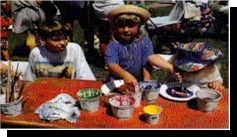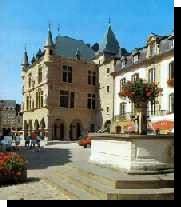



![]()
| The Luxembourg national
motto (52.5k jpg) is:
"Mir wölle bleiwen wat mir sin" or "We
want to remain what we are." Considering the long
history of this little country and the intensely
independent character of its natives, one can see that it
fits very well. Luxembourg was first established in 963 when Count Siegfried acquired the fortress of Lucilinburhuc from Saint Maximinius Abbey in Trier. It flourished as a Duchy in the medieval Europe for nearly 500 years and the dynasty founded by Siegfried provided some of the leading figures of the German empire in the 14th century. It fell under Burgundian domination in 1443. Over the next 400 years, Spanish, French and Austrian armies took turns occupying the fortified capital. In 1815, after the breakup of the napoleonean empire, Luxembourg became a Grand-Duchy under Dutch ruling and finally regained its independence in 1839. |
 |
It was occupied during most of the duration of
both World Wars but the Luxembourg people resisted and fought
valiantly to regain their independence.
![]() Return to
Top
Return to
Top
![]() Back to Home
Page
Back to Home
Page
![]()
If you visit Luxembourg City
and enter one of the shops, you may notice that the Luxembourg
shopkeepers instantly switch back and forth between several
languages as they wait on the foreign tourists. It is quite usual
for a native Luxembourger to be fluent in four or five languages.
Meanwhile, you may hear them conversing among themselves in a
strange German-sounding dialect.
 |
Every Luxembourg child learns German and French beginning in elementary school, but most likely speaks Letzebuergesch as his native tongue at home and while playing with schoolmates. That is why all Luxembourgers are at least trilingual. Many also go on to learn some English, Dutch, Spanish or Italian as well. |
Letzebuergesch is a distinct
language with Germanic origins that date back at least 1000
years. It has differentiated enough that most German speaking
peoples no longer understand it. Technically, it is classified as
a West Moselle Frankish dialect and is closely related to various
dialects spoken in the neighboring regions of Germany, France and
Belgium. Here is a link to an interesting web site by Roger Thijs
discussing these various dialects.
![]() Return to
Top
Return to
Top
![]() Back to Home
Page
Back to Home
Page
![]()
| Fifty days after Easter, on the
Tuesday of the week following Whitsuntide or Pentecost, a strange
medieval ritual is performed in the village of
Echternach. Located on the eastern border of Luxembourg,
Echternach is dominated by the
Benedictine abbey of saint Willibrord first established there in the seventh century. This abbey, once a
medieval scriptorium famous for producing illuminated
copies of religious texts, houses the remains of saint
Willibrord in its crypt and is the focus of the peculiar
"dancing procession". |
 |
The unusual custom began in the fourteenth or fifteenth century
in connection with the annual tithe processions. People from all
parishes under the jurisdiction of the abbey would walk to
Echternach during the Whitsuntide holidays bearing their
offerings. Historical references mention that pilgrims from the
village of Waxweiler would perform a sort of "hopping
dance" as they proceeded to the abbey.
 |
Every Spring on Whit Tuesday, this
medieval procession is repeated. Following a pontifical
mass, a procession of pilgrims wend their way through the
streets of Echternach and back to the tomb of Saint
Willibrord in the crypt of the basilica. The participants
cover the entire route slowly hopping from one foot to
the other in time to an endlessly repeated melody
supplied by groups of musicians. The procession usually includes dozens of musical groups repeating the same ancient melody for hours while several thousand pilgrims perform the hopping dance along the route. This unusual festival draws tens of thousands of spectators. |
http://www.oocities.org/SunsetStrip/Alley/5297/sprang.mid from John Moris' page of ancient Luxembourg music
at: http://www.restena.lu/primaire/consdorf/luxmidi/luxmidi.html .
![]() Return to Top
Return to Top
![]() Back to Home
Page to learn more about
Luxembourg, that fairy tale monarchy with magnificent castles and
quaint villages.
Back to Home
Page to learn more about
Luxembourg, that fairy tale monarchy with magnificent castles and
quaint villages.